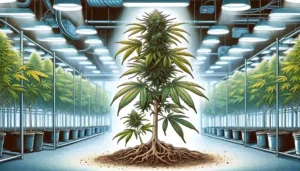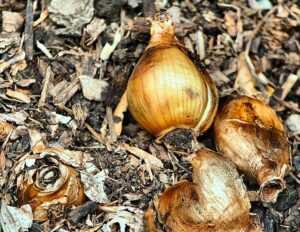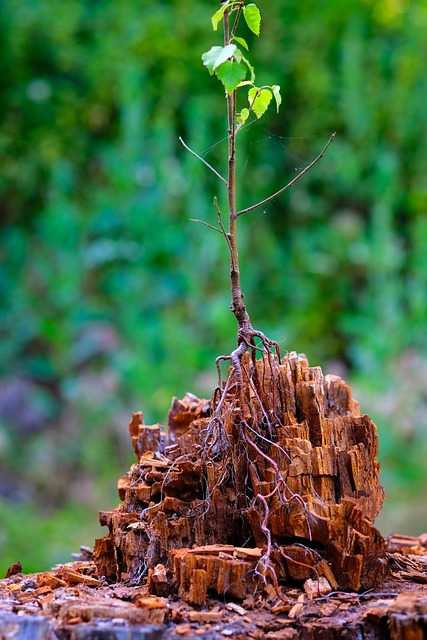This guide provides comprehensive information on the process of ensuring successful root development in cannabis clones. It explores multiple techniques, best practices, and the science behind rooting cannabis clones, aiming to help both novice and seasoned growers achieve cannabis clone rooting success.
Understanding The Basics of Rooting Cannabis Clones
Rooting cannabis clones is a critical step in the cultivation process, as it ensures the successful development of new roots for the clones to thrive. To fully understand this process, it is important to grasp the basics of how rooting works.
When a cannabis clone is taken from a mother plant, it is essentially a small cutting that has the potential to grow into a new plant. However, for this to happen, the clone needs to develop a robust root system. The rooting process involves the clone forming new roots that will absorb water, nutrients, and provide stability for the plant.
Rooting cannabis clones is a delicate process that requires careful attention and specific conditions. It typically involves placing the clones in a suitable rooting medium, such as rockwool cubes or coco coir, which provides support and retains moisture. The clones are then exposed to the right amount of humidity and temperature, ensuring an ideal environment for root development.
During the rooting process, the clones need to be kept in a well-ventilated area that receives ample indirect light. This helps to prevent excess humidity and the possibility of mold or rot. It is crucial to strike a balance between providing enough moisture for root growth without overwatering, which can lead to root rot.
In addition to environmental factors, genetics also play a role in the rooting success of cannabis clones. Some strains may root more easily than others, and it is important to choose healthy mother plants with desirable traits to increase the likelihood of successful rooting. Proper care and attention to detail throughout the process are essential for ensuring the successful development of roots in cannabis clones.
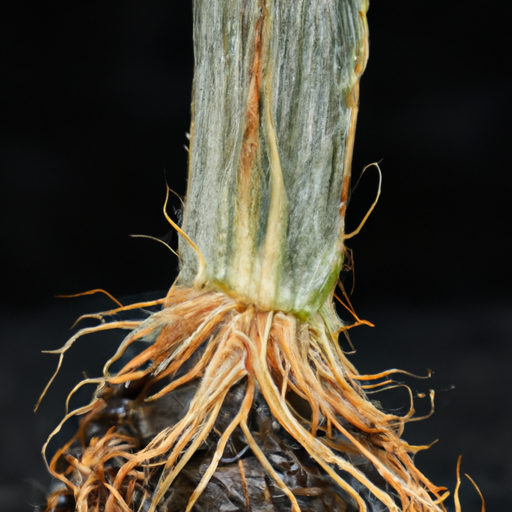
An image showing the structure of a cannabis clone root
What Conditions Are Essential for Root Development?
Root development in cannabis clones requires specific conditions to ensure successful growth. First, maintaining the right temperature is crucial. Ideally, the rooting area should be kept between 70-75°F (21-24°C). This temperature range promotes the metabolic activity of the clone, facilitating root growth.
Secondly, humidity levels need to be carefully controlled. High humidity is necessary to prevent the clones from drying out, as they do not have a developed root system to absorb water. Aim for a humidity level of around 70-80% during the rooting phase. However, it's important to monitor humidity levels closely to avoid excessive moisture, which can lead to mold and other issues.
Next, providing adequate light is essential for root development. While clones do not require intense light during this stage, they still need some level of indirect light. Fluorescent or LED lights with a low wattage can be used to provide the necessary light intensity without causing stress or excessive heat.
Another critical factor for successful root development is the choice of rooting medium. Rockwool cubes, coco coir, and peat pellets are popular choices. These mediums provide support, retain moisture, and allow for proper aeration to encourage root growth. It is important to ensure that the medium is saturated with water but not overly wet, as it can suffocate the developing roots.
Furthermore, maintaining proper air circulation is vital for root development. Good airflow helps prevent the buildup of excess humidity and discourages the growth of mold or fungi. Using fans or vents in the rooting area can help achieve adequate air exchange.
Finally, pH levels of the rooting medium should be within the optimal range of 5.5-6.5. This ensures that the necessary nutrients are available for root development. Regular monitoring and adjustment of pH levels may be necessary to ensure optimal conditions.
The Step-by-Step Process to Rooting Success
Preparing the Clones:
Before starting the rooting process, it is important to ensure that the clones are healthy and free from any pests or diseases. Inspect the clones thoroughly, looking for any signs of damage or discoloration. Trim any excess foliage, leaving only a few healthy leaves on each clone. This will reduce the demand for water and nutrients, allowing the clone to focus its energy on root development.
- Dipping in Rooting Hormone:
To enhance root development, consider using a rooting hormone. Dip the cut end of each clone into a rooting hormone powder or gel. This hormone contains auxins, which stimulate root growth. Ensure that the entire cut end is coated with the hormone, as this will increase the likelihood of successful root development. - Planting the Clones:
Choose a suitable rooting medium, such as rockwool cubes or coco coir, and make small holes or depressions to accommodate the clones. Gently place each clone into the prepared holes, ensuring that the cut end is fully inserted into the rooting medium. Be careful not to damage the delicate roots or disturb the rooting hormone. - Providing the Right Environment:
Place the clones in a humidity dome or propagator to maintain the desired temperature and humidity levels. This enclosed environment will help create a microclimate that promotes root development. Ensure that the dome or propagator is adequately ventilated to prevent excessive moisture buildup. - Maintaining Moisture Levels:
It is crucial to keep the rooting medium moist but not waterlogged. Monitor the moisture levels regularly and mist the clones with water if necessary. Avoid overwatering, as it can lead to rot or other root issues. Maintain a consistent moisture level to provide the clones with the necessary hydration for root development. - Ensuring Proper Lighting:
During the rooting phase, clones do not require intense light. Place them in an area with indirect light or use fluorescent or LED lights with a low wattage. Aim for a light cycle of 18 hours on and 6 hours off to provide the clones with the necessary light energy for photosynthesis without causing stress.
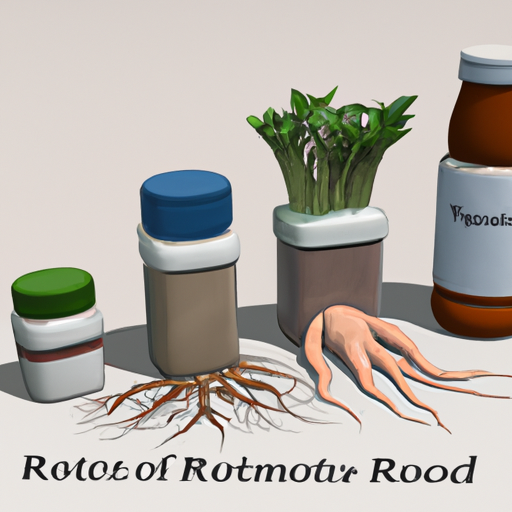
An infographic detailing the step-by-step process of rooting a cannabis clone
Common Pitfalls to Avoid: How Can They Sabotage Your Rooting Success?
In the process of rooting cannabis clones, there are several common pitfalls that can sabotage your success. By being aware of these pitfalls and taking steps to avoid them, you can significantly increase your chances of achieving successful root development.
- 1. Overwatering:
One of the most common mistakes is overwatering the clones. Excessive moisture can lead to root rot and other fungal diseases, ultimately hindering root development. It is important to strike a balance between providing enough moisture to keep the rooting medium moist and avoiding waterlogged conditions. Regularly monitor the moisture levels and adjust watering accordingly. - 2. Improper Temperature and Humidity:
Temperature and humidity play a crucial role in the rooting process. Extreme heat or cold can stress the clones and inhibit root development. Similarly, improper humidity levels can lead to issues such as mold or slow root growth. It is essential to maintain a stable temperature and humidity range, ideally around 70-75°F (21-24°C) and 70-80% relative humidity. Using a thermometer and hygrometer can help you monitor and regulate these factors. - 3. Insufficient Light:
While clones do not require intense light during rooting, they still need a sufficient amount of light energy for photosynthesis and healthy growth. Insufficient light can lead to weak and leggy clones with poor root development. Ensure that the clones are placed in an area with adequate indirect light or use low-wattage fluorescent or LED lights. Aim for a light cycle of 18 hours on and 6 hours off to provide the clones with the necessary light energy.
The Role of Nutrients and Supplements in Root Development
Nutrients and supplements play a vital role in promoting root development in cannabis clones. By providing the necessary elements, you can enhance the rooting process and ensure healthy and robust roots.
- 1. Essential Nutrients:
During the rooting stage, cannabis clones require specific nutrients to support root growth. These include macronutrients such as nitrogen (N), phosphorus (P), and potassium (K), as well as micronutrients like calcium (Ca), magnesium (Mg), and iron (Fe). A balanced nutrient solution or rooting medium should contain these essential elements in appropriate ratios. It is crucial to closely monitor nutrient levels and adjust accordingly to prevent deficiencies or excesses that can impede root development. - 2. Rooting Hormones:
Rooting hormones are supplements that stimulate the formation of roots in cannabis clones. These hormones, such as auxins, encourage cell division and the development of root tissues. Applying rooting hormones to the base of the clone before planting can significantly increase the chances of successful root development. There are different forms of rooting hormones available, including powders, gels, and liquids, each with its own application methods and concentrations. - 3. Beneficial Microbes:
Introducing beneficial microbes to the rooting environment can have a positive impact on root development. These microbes, such as mycorrhizal fungi and beneficial bacteria, establish symbiotic relationships with the roots, aiding in nutrient uptake and improving overall root health. They can also help protect the clones from harmful pathogens. Adding microbial inoculants to the rooting medium or using compost teas can introduce these beneficial microorganisms and enhance root development.
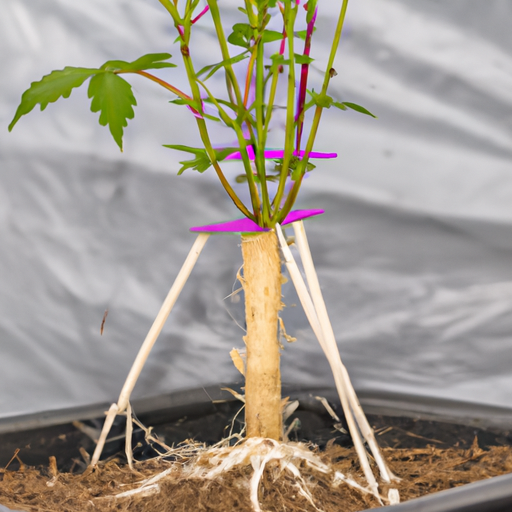
An image showcasing the essential nutrients and supplements for root development
"The secret of getting ahead is getting started." – An Overview of Necessary Tools and Equipment
To ensure successful rooting of cannabis clones, it is essential to have the right tools and equipment at your disposal. These items will help create an environment conducive to root development and make the process more efficient.
- 1. Cloning Gel or Powder:
A cloning gel or powder is a crucial tool for promoting root development in cannabis clones. These products contain hormones and nutrients that stimulate root growth. By applying a small amount to the base of the clone before planting, you can enhance the chances of successful rooting. - 2. Sterile Scalpel or Razor Blade:
A sterile scalpel or razor blade is necessary for taking cuttings from the mother plant. It is important to use a clean and sharp blade to minimize damage to the clone and ensure a clean cut. This will improve the chances of successful root development. - 3. Rooting Medium:
The rooting medium is the material in which the cannabis clone will develop roots. Common options include rockwool, coconut coir, perlite, or a soilless mix. The rooting medium should provide adequate drainage, moisture retention, and aeration to support healthy root development. - 4. Propagation Tray or Dome:
A propagation tray or dome provides a controlled environment for the clones during the rooting process. These containers help maintain high humidity levels, which are crucial for preventing excessive moisture loss through transpiration. Additionally, they protect the clones from environmental stressors and provide a stable environment for root development. - 5. Heating Mat or Propagation Chamber:
Maintaining a consistent temperature is essential for successful root development. A heating mat or propagation chamber can help create the optimal temperature range for root growth. This is particularly important if you are rooting clones in a cooler environment or during colder months.
Monitoring and Caring for Your Cannabis Clones Post-Rooting: What's Next?
Now that your cannabis clones have successfully rooted, it's important to monitor and care for them to ensure their continued growth and development. Here's what you need to do:
- 1. Check for Root Development:
Once the clones have been rooted, carefully remove them from the propagation tray or dome to inspect the root development. Look for healthy, white roots that have spread out in the rooting medium. Avoid disturbing the roots too much, as this can cause damage. - 2. Transplantation:
If the roots have developed well and the clone has outgrown its current container, it's time to transplant it into a larger pot. Choose a pot with good drainage and fill it with a suitable growing medium. Gently transfer the clone, ensuring the roots are covered and supported. Be careful not to damage the tender roots during this process. - 3. Light and Temperature:
Provide your clones with the right amount of light and maintain suitable temperature conditions. Cannabis plants require a minimum of 18 hours of light during the vegetative stage. Place the clones under grow lights or in a well-lit area. Additionally, maintain a temperature range of 70-85°F (21-29°C) to promote healthy growth. - 4. Watering:
Monitor the moisture levels of the soil or growing medium and water the clones as needed. Avoid overwatering, as it can lead to root rot and other issues. Allow the top layer of soil to dry out slightly before watering again. Use clean, pH-balanced water to avoid any nutrient imbalances. - 5. Nutrient Feeding:
As the clones continue to grow, they will require appropriate nutrients for optimal development. Start with a mild nutrient solution and gradually increase the dosage as the plants mature. Monitor the plants for any signs of nutrient deficiencies or excesses and adjust the feeding accordingly.
How to Ensure Rooting Success in Cannabis Clones: A Step-by-Step Process:
| Step | Description | Tools | Time |
|---|---|---|---|
| Select Healthy Clone | Select clones with healthy leaves, stems, and roots | Magnifying glass | 5-10 minutes |
| Cut Plant | Cut the plant below the node using a sharp, sterilized blade | Sharp, sterile blade | 5 minutes |
| Prepare Soil | Prepare soil with good drainage and aeration | Soil, water, and fertilizer | 15-20 minutes |
| Plant Clone | Plant the clone in the prepared soil | Planting tray and soil | 5 minutes |
Achieving rooting success in cannabis clones is a meticulous process that requires patience, understanding, and the right technique. By following the steps outlined, understanding the science behind it, and taking care of the necessary conditions, growers can significantly increase their chances of success. Ultimately, the key to cannabis clone rooting success lies in maintaining appropriate environmental conditions, proper handling, and consistent monitoring.


